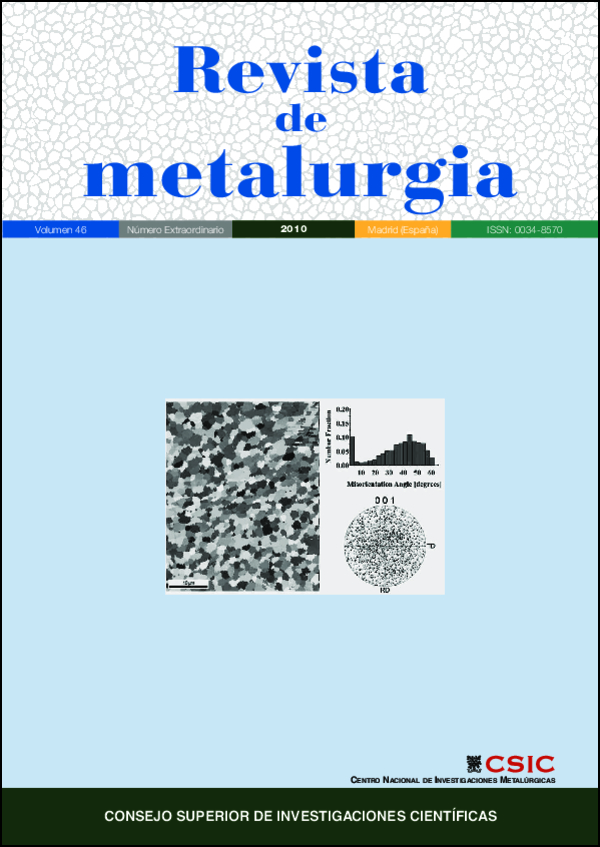Definición de una metodología optimizada para la simulación del desgaste en materiales metálicos
DOI:
https://doi.org/10.3989/revmetalmadrid.11XIIPMSPalabras clave:
Desgaste, Elementos finitos, Acelerador variable, Materiales metálicos, Metodología optimizadaResumen
La simulación del desgaste mediante el Método de Elementos Finitos (MEF) es una técnica que presenta grandes ventajas para la mejora del diseño de componentes ya que permite reducir el coste que conlleva la experimentación (tiempo de ensayo, materiales, medidas tribológicas). En el caso concreto de la optimización de sistemas multihilo sometidos a fretting, como es el caso de los cables metálicos donde se dan contactos cilindro-cilindro, este método puede resultar especialmente eficiente. Sin embargo, la simulación del desgaste resulta una técnica compleja ya que consta de dos núcleos importantes: por un lado, la resolución del contacto y, por otro, la introducción del modelo de desgaste, requiriendo, para ello, de un coste computacional muy importante. Por ello, en este trabajo se define una metodología a seguir con el fin de optimizar el modelo, en términos de tiempo computacional, para un sistema bloque-cilindro. La metodología definida sería aplicable a todos los modelos de desgaste, de geometrías más complejas. Finalmente, se introduce una técnica que consiste en la introducción de un acelerador de desgaste variable y autoajustable, teniendo en cuenta la evolución de la presión máxima de desgaste y el incremento umbral de desgaste. Esta técnica resulta indispensable en cuerpos sometidos a grandes desgastes, reduciendo el tiempo computacional en un 87 % y un error inferior al 1 %.
Descargas
Citas
[1] M.A. Urchegui,W. Tato y X. Gómez, J.Mater. Eng. Perform. 17 (2007) 550–560. doi:10.1007/s11665-007-9165-5
[2] P. Podra y S. Andersson, Tribol. Int. 32 (1999) 71-81. doi:10.1016/S0301-679X(99)00012-2
[3] V. Hegadekatte, N. Huber y O. Kraft,Modelling. Simul. Mater. Sci. Eng. 13 (2005) 57-75. [4] N.H. Kim, D. Won, D. Burris, B. Holtkamp, G.R. Gessel, P. Swanson yW.G. Sawyer,Wear 25 (2005) 1.787-1.793.
[5] M. Oqvist, Wear 249 (2001) 6-11. doi:10.1016/S0043-1648(00)00548-2
[6] I.R. McColl, J. Ding y S.B. Leen, Wear 256 (2004) 1.114-1.1127.
[7] S. Fouvry, C. Paulin y C. Meunier, Wear 264 (2008) 26-36. doi:10.1016/j.wear.2007.01.037
[8] J. Ding, I.R. McColl y S.B. Leen, Wear 262 (2007) 1.205-1.216.
[9] R. Hernández, M. Riera y J.M. Prado, Reunión de usuarios de Abaqus, Madrid, 2006, http://www.principia.es/abaqus/usuarios_archivo.htm (obtenida 25.02.2011).
[10] V. Hegadekatte, S. Kurzenhäuser, N. Huber, O. Kraft, Tribol. Int. 41 (2008) 1.020-1.031.
[11] J. Ding, S.B. Leen, E.J.Willians y P.H. Shipway, Tribol. Mater. Surf. Interf. 2 (2008) 10-24. 0
[12] A. Cruzado, M. Hartelt, R. Wäsche, M.A. Urchegui y X. Gómez,Wear 268 (2010) 1.409- 1.416.
[13] S. Fouvry, T. Liskiewicz y C. Paulin, Wear 263 (2007) 518-531. doi:10.1016/j.wear.2007.01.072
[14] J. Ding, Thesis, University of Nothingan, 2008.
Descargas
Publicado
Cómo citar
Número
Sección
Licencia
Derechos de autor 2010 Consejo Superior de Investigaciones Científicas (CSIC)

Esta obra está bajo una licencia internacional Creative Commons Atribución 4.0.
© CSIC. Los originales publicados en las ediciones impresa y electrónica de esta Revista son propiedad del Consejo Superior de Investigaciones Científicas, siendo necesario citar la procedencia en cualquier reproducción parcial o total.
Salvo indicación contraria, todos los contenidos de la edición electrónica se distribuyen bajo una licencia de uso y distribución “Creative Commons Reconocimiento 4.0 Internacional ” (CC BY 4.0). Consulte la versión informativa y el texto legal de la licencia. Esta circunstancia ha de hacerse constar expresamente de esta forma cuando sea necesario.
No se autoriza el depósito en repositorios, páginas web personales o similares de cualquier otra versión distinta a la publicada por el editor.
















